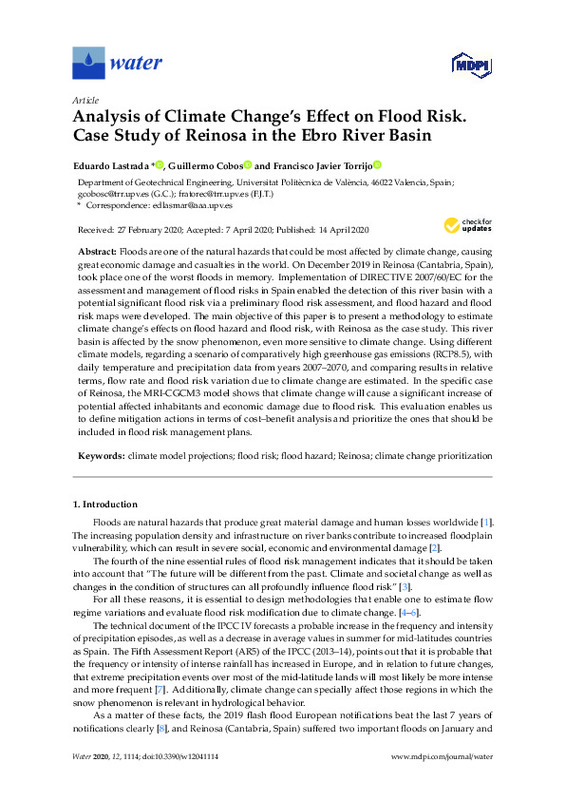JavaScript is disabled for your browser. Some features of this site may not work without it.
Buscar en RiuNet
Listar
Mi cuenta
Estadísticas
Ayuda RiuNet
Admin. UPV
Analysis of Climate Change s Effect on Flood Risk. Case Study of Reinosa in the Ebro River Basin
Mostrar el registro sencillo del ítem
Ficheros en el ítem
| dc.contributor.author | LASTRADA MARCÉN, JOSÉ EDUARDO
|
es_ES |
| dc.contributor.author | Cobos Campos, Guillermo
|
es_ES |
| dc.contributor.author | Torrijo, F.J.
|
es_ES |
| dc.date.accessioned | 2020-05-22T03:02:23Z | |
| dc.date.available | 2020-05-22T03:02:23Z | |
| dc.date.issued | 2020-04-14 | es_ES |
| dc.identifier.issn | 2073-4441 | es_ES |
| dc.identifier.uri | http://hdl.handle.net/10251/144082 | |
| dc.description.abstract | [EN] Floods are one of the natural hazards that could be most affected by climate change, causing great economic damage and casualties in the world. On December 2019 in Reinosa (Cantabria, Spain), took place one of the worst floods in memory. Implementation of DIRECTIVE 2007/60/EC for the assessment and management of flood risks in Spain enabled the detection of this river basin with a potential significant flood risk via a preliminary flood risk assessment, and flood hazard and flood risk maps were developed. The main objective of this paper is to present a methodology to estimate climate change¿s effects on flood hazard and flood risk, with Reinosa as the case study. This river basin is affected by the snow phenomenon, even more sensitive to climate change. Using different climate models, regarding a scenario of comparatively high greenhouse gas emissions (RCP8.5), with daily temperature and precipitation data from years 2007¿2070, and comparing results in relative terms, flow rate and flood risk variation due to climate change are estimated. In the specific case of Reinosa, the MRI-CGCM3 model shows that climate change will cause a significant increase of potential affected inhabitants and economic damage due to flood risk. This evaluation enables us to define mitigation actions in terms of cost¿benefit analysis and prioritize the ones that should be included in flood risk management plans. | es_ES |
| dc.language | Inglés | es_ES |
| dc.publisher | MDPI AG | es_ES |
| dc.relation.ispartof | Water | es_ES |
| dc.rights | Reconocimiento (by) | es_ES |
| dc.subject | Climate model projections | es_ES |
| dc.subject | Flood risk | es_ES |
| dc.subject | Flood hazard | es_ES |
| dc.subject | Reinosa | es_ES |
| dc.subject | Climate change prioritization | es_ES |
| dc.subject.classification | INGENIERIA DEL TERRENO | es_ES |
| dc.title | Analysis of Climate Change s Effect on Flood Risk. Case Study of Reinosa in the Ebro River Basin | es_ES |
| dc.type | Artículo | es_ES |
| dc.identifier.doi | 10.3390/w12041114 | es_ES |
| dc.relation.projectID | info:eu-repo/grantAgreement/AEI/Plan Estatal de Investigación Científica y Técnica y de Innovación 2017-2020/RTI2018-095302-B-I00/ES/LA ARQUITECTURA DE TIERRA EN LA PENINSULA IBERICA: ESTUDIO DE LOS RIESGOS NATURALES, SOCIALES Y ANTROPICOS Y ESTRATEGIAS DE INTERVENCION E INCREMENTO DE LA RESILIENCIA/ | |
| dc.rights.accessRights | Abierto | es_ES |
| dc.contributor.affiliation | Universitat Politècnica de València. Departamento de Ingeniería del Terreno - Departament d'Enginyeria del Terreny | es_ES |
| dc.description.bibliographicCitation | Lastrada Marcén, JE.; Cobos Campos, G.; Torrijo, F. (2020). Analysis of Climate Change s Effect on Flood Risk. Case Study of Reinosa in the Ebro River Basin. Water. 12(4):1-14. https://doi.org/10.3390/w12041114 | es_ES |
| dc.description.accrualMethod | S | es_ES |
| dc.relation.publisherversion | https://doi.org/10.3390/w12041114 | es_ES |
| dc.description.upvformatpinicio | 1 | es_ES |
| dc.description.upvformatpfin | 14 | es_ES |
| dc.type.version | info:eu-repo/semantics/publishedVersion | es_ES |
| dc.description.volume | 12 | es_ES |
| dc.description.issue | 4 | es_ES |
| dc.relation.pasarela | S\407677 | es_ES |
| dc.description.references | Flood Risk Management: A Strategic Approach https://unesdoc.unesco.org/ark:/48223/pf0000220870 | es_ES |
| dc.description.references | Doroszkiewicz, J., Romanowicz, R., & Kiczko, A. (2018). The Influence of Flow Projection Errors on Flood Hazard Estimates in Future Climate Conditions. Water, 11(1), 49. doi:10.3390/w11010049 | es_ES |
| dc.description.references | Zhu, T., Lund, J. R., Jenkins, M. W., Marques, G. F., & Ritzema, R. S. (2007). Climate change, urbanization, and optimal long-term floodplain protection. Water Resources Research, 43(6). doi:10.1029/2004wr003516 | es_ES |
| dc.description.references | Nyaupane, N., Thakur, B., Kalra, A., & Ahmad, S. (2018). Evaluating Future Flood Scenarios Using CMIP5 Climate Projections. Water, 10(12), 1866. doi:10.3390/w10121866 | es_ES |
| dc.description.references | Intergovernmental Panel on Climate Change https://archive.ipcc.ch/ | es_ES |
| dc.description.references | European Flood Awareness System (EFAS) https://www.efas.eu/en/news/summary-efas-notifications-2019 | es_ES |
| dc.description.references | Garijo, C., & Mediero, L. (2018). Influence of climate change on flood magnitude and seasonality in the Arga River catchment in Spain. Acta Geophysica, 66(4), 769-790. doi:10.1007/s11600-018-0143-0 | es_ES |
| dc.description.references | Garijo, C., Mediero, L., & Garrote, L. (2018). Utilidad de las proyecciones climáticas generadas por AEMET para estudios de impacto del cambio climático sobre avenidas a escala nacional. Ingeniería del agua, 22(3), 153. doi:10.4995/ia.2018.9312 | es_ES |
| dc.description.references | ASTER. Modelo Hidrológico De Simulación Y Previsión Aplicado A Cuencas Donde El Fenómeno Nival Es Relevante http://www.spesa.es/paginas/basededatos/ASTER_Manual_Usuario.pdf | es_ES |
| dc.description.references | Policy-Relevant Assessment of Socio-Economic Effects of Droughts and Floods, To Establish a Damage-Water Depth Relationship http://www.feem-project.net/preempt/ | es_ES |
| dc.description.references | Cobos, G., Francés, M., & Arenillas, M. (2010). Le programme ERHIN. Modélisation nivo-hydrologique pour la gestion de l’eau du bassin de l’Ebre. La Houille Blanche, (3), 58-64. doi:10.1051/lhb/2010035 | es_ES |
| dc.description.references | Anderson, E. A. (1968). Development and testing of snow pack energy balance equations. Water Resources Research, 4(1), 19-37. doi:10.1029/wr004i001p00019 | es_ES |
| dc.subject.ods | 13.- Tomar medidas urgentes para combatir el cambio climático y sus efectos | es_ES |
| dc.subject.ods | 11.- Conseguir que las ciudades y los asentamientos humanos sean inclusivos, seguros, resilientes y sostenibles | es_ES |








